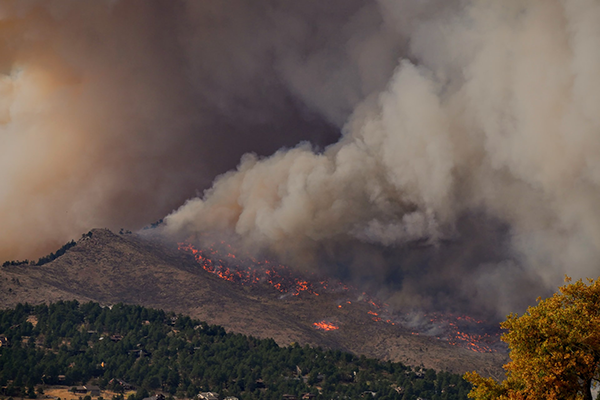A .gov website belongs to an official government organization in the United States.
A lock () or https:// means you've safely connected to the .gov website. Share sensitive information only on official, secure websites.
18 August 2022
adapted from the NCAR Press Release

A major study highlights five critical challenges. As wildfires cause increasing devastation worldwide, dozens of fire experts across the nation are joining together in calling for a more strategic and interdisciplinary approach to pursuing wildfire research and protecting vulnerable communities.
A new study, led by a scientist at the National Center for Atmospheric Research (NCAR) and co-authored by 86 other fire experts from a breadth of disciplines, including CSL's Megan Bela, highlights the obstacles for fire science and provides guidance for investing in future research. The commentary is a follow-up to a five-day innovation lab, sponsored by the U.S. National Science Foundation (NSF), that brought together diverse research communities in May 2021 to develop a roadmap for new research directions.
Published in the Proceedings of the National Academy of Sciences (PNAS) Nexus journal, the study outlines five key challenges to advance the study of fire. These range from promoting coordinated research to drawing on diverse sources of knowledge.
"We need to develop a proactive fire research agenda that helps create safe communities and ecosystems," said NCAR scientist Jacquelyn Shuman, the lead author. "This requires a more cross-disciplinary approach and building diverse partnerships to make better use of the knowledge that exists."
The scientists are making their recommendations at a time when wildfires pose an increasing global risk, spurred largely by climate change, generations of fire suppression, and more development in the wildland-urban interface. Recent decades have seen a substantial increase in the length of fire season as far north as the Arctic, as well as intense conflagrations from the Pantanal tropical wetland in South America to the peatlands of tropical Asia. In the western United States, warmer and drier conditions have spurred fires that have burned nearly twice the area in the 21st century compared with the late 20th century.
Despite the growing wildfire destruction, the authors emphasize fire is a fundamental part of ecosystems globally, and it has been used by society to manage landscapes for millennia.
Using increasingly advanced observing systems, field campaigns and computer models, scientists have made major strides in better understanding and anticipating wildfire behavior, as well as the effects of smoke on air quality. However, such advances have often been made in isolation, instead of being incorporated into a comprehensive and holistic understanding of the causes and impacts of fires.
Recognizing the need for a more convergent approach, the innovation lab last year brought together experts at federal agencies and universities. They represented fields ranging from ecology, forestry and anthropology to geomorphology, hydrology, and computer science, among others.
The five challenges outlined in the paper, which built on those discussions, are:
"We have far more information about fires than before, but we need increased funding and better coordination to deploy it on a global scale," Shuman said. "This will enable us to be more proactive as we work to help society and ecosystems become more resilient to the increasing risk of fires."
Shuman, J.K., J.K. Balch, R.T. Barnes, P.E. Higuera, C.I. Roos, D.W. Schwilk, E.N. Stavros, T. Banerjee, M.M. Bela, J. Bendix, S. Bertolino, S. Bililign, K.D. Bladon, P. Brando, R.E. Breidenthal, B. Buma, D. Calhoun, L.M.V. Carvalho, M.E. Cattau, K.M. Cawley, S. Chandra, M.L. Chipman, J. Cobian-Iñiguez, E. Conlisk, J.D. Coop, A. Cullen, K.T. Davis, A. Dayalu, F. De Sales, M. Dolman, L.M. Ellsworth, S. Franklin, C.H. Guiterman, M. Hamilton, E.J. Hanan, W.D. Hansen, S. Hantson, B.J. Harvey, A. Holz, T. Huang, M.D. Hurteau, N.T. Ilangakoon, M. Jennings, C. Jones, A. Klimaszewski-Patterson, L.N. Kobziar, J. Kominoski, B. Kosovic, M.A. Krawchuk, P. Laris, J. Leonard, S.M. Loria-Salazar, M. Lucash, H. Mahmoud, E. Margolis, T. Maxwell, J.L. McCarty, D.B. McWethy, R.S. Meyer, J.R. Miesel, W.K. Moser, R.C. Nagy, D. Niyogi, H.M. Palmer, A. Pellegrini, B. Poulter, K. Robertson, A.V. Rocha, M. Sadegh, F. Santos, F. Scordo, J.O. Sexton, A.S. Sharma, A.M.S. Smith, A.J. Soja, C. Still, T. Swetnam, A.D. Syphard, M.W. Tingley, A. Tohidi, A.T. Trugman, M. Turetsky, J.M. Varner, Y. Wang, T. Whitman, S. Yelenik, and X. Zhang, Reimagine fire science for the anthropocene, Proceedings of the National Academy of Sciences (PNAS) Nexus, doi:10.1093/pnasnexus/pgac115, 2022.
Fire is an integral component of ecosystems globally and a tool that humans have harnessed for millennia. Altered fire regimes are a fundamental cause and consequence of global change, impacting people and the biophysical systems on which they depend. As part of the newly emerging Anthropocene, marked by human-caused climate change and radical changes to ecosystems, fire danger is increasing, and fires are having increasingly devastating impacts on human health, infrastructure, and ecosystem services. Increasing fire danger is a vexing problem that requires deep transdisciplinary, trans-sector, and inclusive partnerships to address. Here, we outline barriers and opportunities in the next generation of fire science and provide guidance for investment in future research. We synthesize insights needed to better address the long-standing challenges of innovation across disciplines to (i) promote coordinated research efforts; (ii) embrace different ways of knowing and knowledge generation; (iii) promote exploration of fundamental science; (iv) capitalize on the "firehose" of data for societal benefit; and (v) integrate human and natural systems into models across multiple scales. Fire science is thus at a critical transitional moment. We need to shift from observation and modeled representations of varying components of climate, people, vegetation, and fire to more integrative and predictive approaches that support pathways toward mitigating and adapting to our increasingly flammable world, including the utilization of fire for human safety and benefit. Only through overcoming institutional silos and accessing knowledge across diverse communities can we effectively undertake research that improves outcomes in our more fiery future.